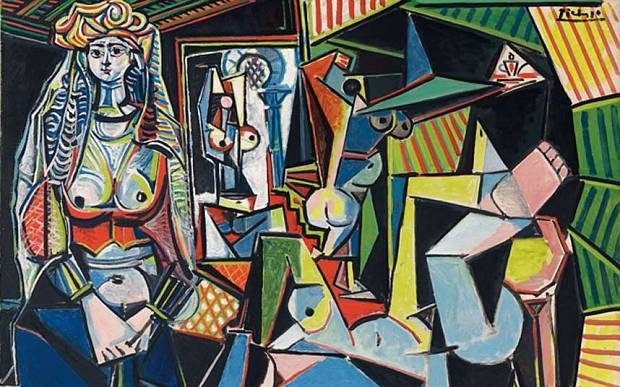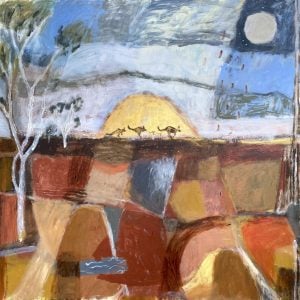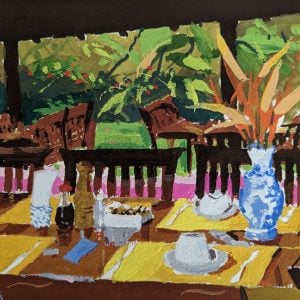Kim Leutwyler talks art, queer identity and self expression.
Kim Leutwyler is an American artist currently living in Sydney, Australia. She works in a variety of media including painting, installation, ceramics, print-media and drawing. Kim holds concurrent degrees in Studio and Art History from Arizona State University and also graduated from the School of the Art Institute of Chicago with a Painting and Drawing degree. Constantly seeking new experiences and imagery, Kim has traveled extensively throughout North America, the European continent, Asia and the South Pacific region. Kim’s current work takes its form in paintings dealing with images of beauty, gender and Queer-identity. Her artwork has been exhibited in multiple galleries throughout the United States and Australia, and she is part of a permanent collection at both the Naestved Cultural Center in Denmark and the Brooklyn Art Library in New York.
Kim currently works from her home studio, a small space with great natural light and high ceilings for when she create’s large-scale work. It’s a quiet, clean and organised workspace with a number of paintings by herself and others displayed on the wall for inspiration. Her favourite painting is a landscape piece featuring a family of elk in a valley. She found the painting in a basement of a local antique shop for $5! Kim loves its original brushwork and technique; the elks eyes look like they are about to pop out of their sockets! “What can I say? I love it! I look to the painting for inspiration regularly.”, Kim explains.
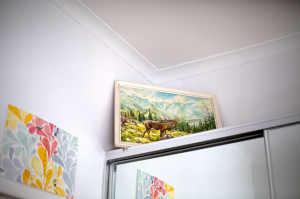
Ceramics, sculpture, printmaking and textiles have all moonlighted as Kim’s favourite medium since high school. The main obstacle she faced after University was that she had very little opportunity to use the facilities required to create new work. Ceramics requires a kiln and wheel at the very minimum, lithography requires a slab of stone or aluminium plate, acid and a giant press! “When I found myself in search of a creative outlet, I turned to drawing and painting with my roommate in our living room. I quickly realised that I wanted to learn from the very best Painters and Scholars in the world. After applying to all of the top painting schools, (Yale, RISD, SVA, etc.) I was fortunate to attend The School of the Art Institute of Chicago.” She has been dedicated solely to painting ever since.
Kim describes her paintings as figures of LGBTQ identified and Queer-allied women. Most recently she has focused on those who have impacted her life in some way. Her work toys with the concept of glorification vs objectification vs modification. She incorporates various facets of nature into their work in order to comment on the mutability of identity, gender and beauty through pattern and abstraction. Kim occasionally takes on commission work, although she asks for artistic freedom when creating a commissioned piece. She recently created a painting for a beautiful couple in Sydney to celebrate their anniversary. The commissioner, Sam, surprised her girlfriend with a portrait based on a photo she took on a special night out together. She provided Kim with the photo of her girlfriend and gave her the freedom to paint whatever she thought most appropriate. “I consulted with her throughout the process to ensure that the composition, palette and pattern were suitable and opened up a dialogue for critical feedback in case anything looked ‘off’.” She loves this kind of collaboration because it broadens her subject matter and pushes her to try new things while still remaining true to her artistic integrity and vision.
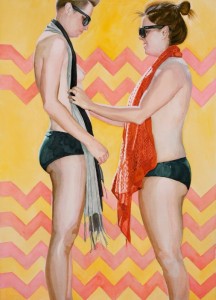
Kim enjoys visiting galleries of all shapes and sizes. Her all-time favourite is the Saatchi Gallery in London. “It is by far the most innovative space for contemporary art, displaying a mix of both emerging young artists and the rock stars of the art world.” Kim’s first exhibition was at a place called Wet Paint with a Big Lebowski theme. She painted a monochromatic portrait of Maude. The opening night featured a live band playing the entire soundtrack, in costume. To this date, this exhibition remains Kim’s favourite.
Enjoying the ornate imagery in particular, Kim is most drawn to the Pre-Raphaelites movement. Made up of English painters and poets from the mid 1800’s. They rejected artistic trends of the time and returned to intricate detail, saturated colours and intense compositions that could be found in earlier Italian works. “They were attacked by critics for being too medieval and resistant to change, but I love looking through the amazingly abundant detail in their patterns, paintings and textiles. Learning about the Pre-Raphaelites had a huge influence on my use of pattern today.”
Pattern Time Lapse from Kim Leutwyler on Vimeo.
If Kim could collaborate with one artist dead or alive, she would choose Robert Rauschenberg. The first time she saw his paintings in the San Fransisco MoMA she was so drawn to it, she sat there staring at it for 45 minutes, something Kim had never done in a museum before. “Rauschenberg often combined things like taxidermy animals, furniture and painted canvas to make enormous pieces. He also dedicated his millions toward establishing multiple organisations that support causes like world peace, the environment and humanitarian issues.” Kim’s only regret was not reaching out to him to express how much his work meant to her whilst he was alive.
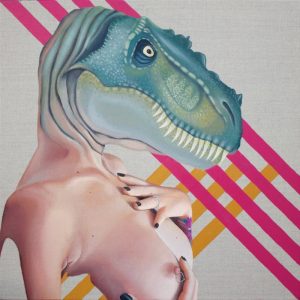
Queer Dinosaur
Given an unlimited amount of funds to create whatever, Kim would like to make a series of LGBTQ portraits juxtaposed with rooms filled floor to ceiling with artificial floral installations, leveraging the language and politics of flowers to comment on the mutability of life, gender and beauty. “Queer identities have varying aesthetics which metamorphose based on age, race, geography etc. The bodies of queer-identified and allied individuals in my paintings are evolving with their social environment.” By significantly increasing the scale of her work and integrating a new element, artificial flowers, she would push the boundaries of her current practice.
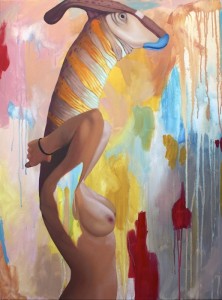
Parasaurolophus Lex
Generally speaking, flowers in fine art raise more questions than they answer. Though their visual appeal is straightforward, the interpretation of their bewildering array of meaning is complicated and often contradictory. The flower can function as a vehicle for contemplating concepts of sex, decay, gender politics, our environment, decadence, ceremony and the mutability of life, love and death. From the Transexual Aztec Flower God Xochipilli to Oscar Wilde’s floral discourse legitimizing homosexual love, the language of flowers has often appeared in the history of the LGBTQ community. Kim would use new and recycled white silk flowers, which would then be hand painted and arranged by the audience and herself throughout the development. She would use primarily recycled/rescued silk flowers that each have a history of their own to build an iconic arrangement upon which the viewer could cast their own interpretations. “If it seems relevant, the audience and I may decide to explore alternative materials for constructing artificial flowers. The use of white silk flowers in particular would give me total control over their final colour, allowing me to explore flower politics in an artificial gesture.”
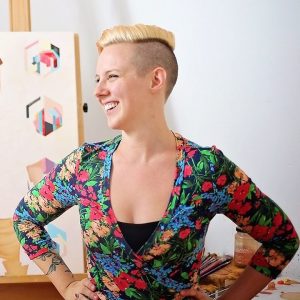
Kim’s advice for aspiring artists? “Put your work out there and take some big risks. Try something new and don’t let yourself be restricted by your medium. Surround yourself with people that you trust to provide open and honest feedback. Can’t find someone? Reach out to me!”
Find more of Kim Leutwyler’s work available to buy
here and keep up to date with Kim’s creations at her
website.
Top 10 most expensive paintings in the world







